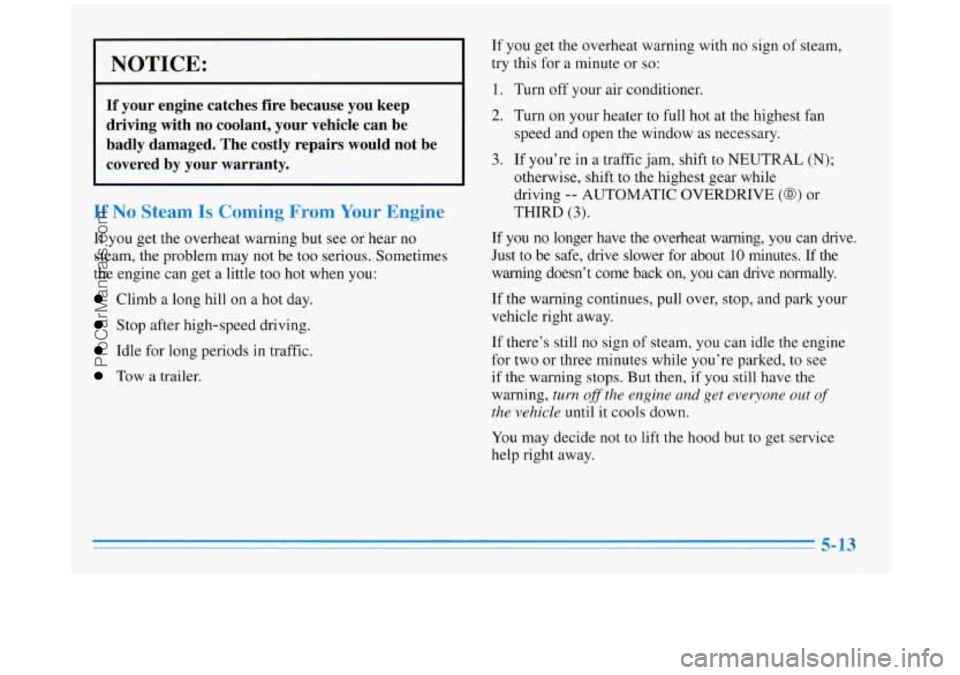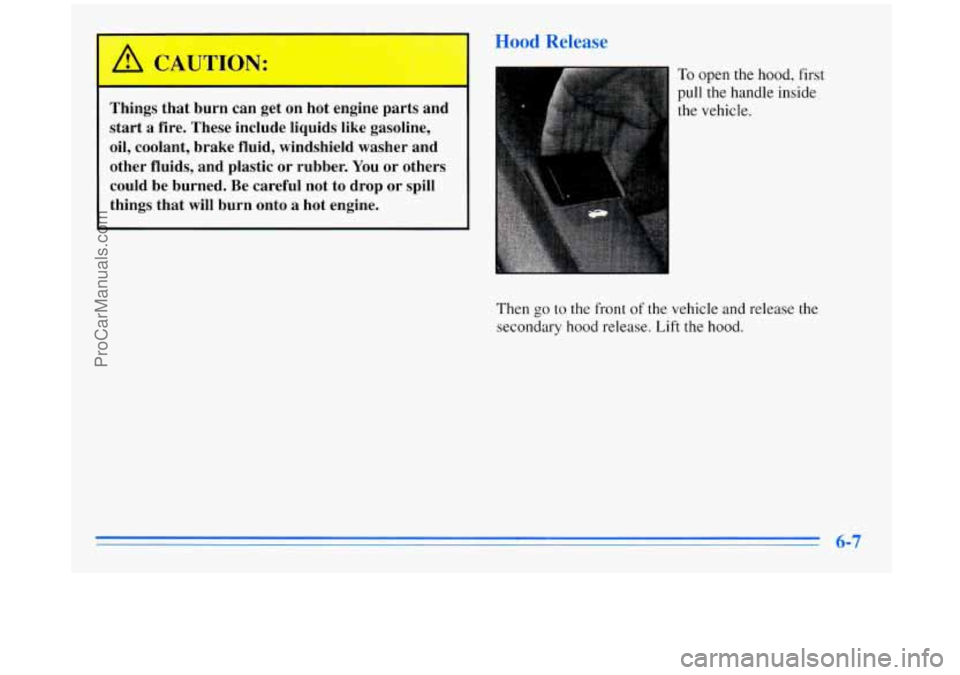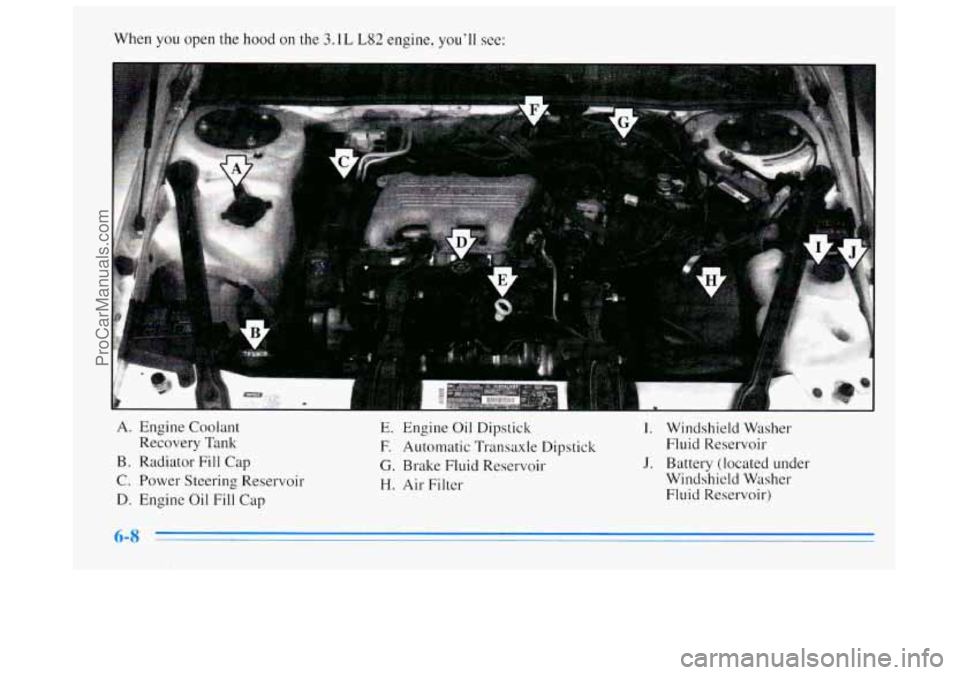open hood BUICK REGAL 1996 Owners Manual
[x] Cancel search | Manufacturer: BUICK, Model Year: 1996, Model line: REGAL, Model: BUICK REGAL 1996Pages: 356, PDF Size: 17.97 MB
Page 79 of 356

Engine Coolant Heater (Option)
In very cold weather,
0°F (-1 8°C) or colder,
the engine coolant
heater can help. You’ll
get easier starting and
better fuel economy
during engine warm-up.
Usually, the coolant heater should be plugged
in a
minimum of four hours prior to starting your vehicle.
To Use the Coolant Heater
I. Turn off the engine.
2. Open the hood and unwrap the electrical cord.
3. Plug it into a normal, grounded 110-volt AC outlet.
Plugging the cord into an ungrounded outlet
could cause an electrical shock.
Also, the wrong
kind
of extension cord could overheat and cause
a fire. You could be seriously injured. Plug the
cord into a properly grounded three-prong
110-volt
AC outlet. If the cord won’t reach, use a
heavy-duty three-prong extension cord rated for
at least
15 amps.
4. After you’ve used the coolant heater, be sure to store
the cord as it was before to keep it away from moving
engine parts.
If you don’t, it could be damaged.
How long should
you keep the coolant heater plugged
in? The answer depends on the outside temperature,
the
kind of oil you have, and some other things. Instead of
trying to list everything here, we ask that you contact
your Buick dealer
in the area where you’ll be parking
your vehicle. The dealer can give you the best advice for
that particular area.
ProCarManuals.com
Page 191 of 356

2. Get the vehicles close enough so the jumper cables
can reach, but be sure the vehicles aren’t touching
each other. If they are, it could cause a ground
connection you don’t want.
You wouldn’t be able to
start your Buick, and the bad grounding could
damage the electrical systems.
You could be injured if the vehicles roll. Set the
parking brake firmly on each vehicle.
Put an
automatic transaxle in PARK
(P) or a manual
transaxle in NEUTRAL
(N).
3. Turn off the ignition on both vehicles. Unplug
unnecessary accessories plugged into the cigarette
lighter or accessory power outlet. Turn off all lamps
that aren’t needed as well as radios. This will avoid
sparks and help save both batteries. In addition,
it
could save your radio!
I I
I NOTICE:
If you leave your radio on, it could be badly
damaged. The repairs wouldn’t be covered by
your warranty.
4. Open the hoods and locate the batteries.
An electric fan can start up even when the engine
is not running and can injure you. Keep hands,
clothing and tools away from any underhood
electric fan.
5. Find the positive (+) and negative (-) terminals on
each battery. Your Buick has a remote positive
(+)
jump starting terminal. The terminal is on the same
side
of the engine compartment as your battery. You
should always use
the remote positive (+) terminal
instead
of the positive (+) terminal on your battery.
To uncover the remote positive (+) terminal, lift the
red plastic cap.
5-3
ProCarManuals.com
Page 200 of 356

Engine Overheating
YOU will find a coolant temperature gage and a warning
light about a hot engine on your instrument panel. See
“Engine Coolant Temperature Gage” and “Engine
Coolant Temperature Warning Light” in the Index.
You also have a LOW COOLANT warning light on
your instrument panel. See “Low Coolant Light” in
the Index.
If Steam Is Coming From Your Engine
Steam from an overheated engine can burn you
badly, even
if you just open the hood. Stay away
from the engine if you see or hear steam coming
from it. Just turn it off and get everyone away
from the vehicle until it cools down. Wait until
there is
no sign of steam or coolant before
opening the hood.
If you keep driving when your engine is
overheated, the liquids in it can catch fire. You
or others could be badly burned. Stop your
engine if it overheats, and get out of the vehicle
until the engine is cool.
5-12
ProCarManuals.com
Page 201 of 356

NOTICE:
If your engine catches fire because you keep
driving with no coolant, your vehicle can be
badly damaged. The costly repairs would not be
covered by your warranty.
If No Steam Is Coming From Your Engine
If you get the overheat warning but see or hear no
steam, the problem may not be too serious. Sometimes
the engine can get a little too hot when you:
Climb a long hill on a hot day.
Stop after high-speed driving.
Idle for long periods in traffic.
Tow a trailer. If you
get the overheat warning with no sign of steam,
try this for a minute or
so:
I. Turn off your air conditioner.
2. Turn on your heater to full hot at the highest fan
speed and open the window as necessary.
3. If you’re in a traffic jam, shift to NEUTRAL (N);
otherwise, shift to the highest gear while
driving
-- AUTOMATIC OVERDRIVE (@) or
THIRD
(3).
If you no longer have the overheat warning, you can drive.
Just to be safe, drive slower for about
10 minutes. If the
warning doesn’t come back on, you can drive normally.
If the warning continues, pull over, stop, and park your
vehicle right away.
If there’s still no sign
of steam, you can idle the engine
for two or three minutes while you’re parked, to see
if the warning stops. But
then, if you still have the
warning,
turn ofSthe engine and get everyone out of
the vehicle until it cools down.
You may decide not to lift the hood but to get service
help right away.
ProCarManuals.com
Page 228 of 356

CAUTION:
If you get gasoline on yourself and then
something ignites it, you could be badly burned.
Gasoline can spray out on you if
you open the
fuel filler cap too quickly. This spray can happen
if your tank is nearly full, and
is more likely in
hot weather. Open the fuel filler cap slowly and
wait
for any “hiss” noise to stop. Then unscrew
the cap all the way.
Be careful not to spill gasoline. Clean gasoline
from
painted surfaces as soon as possible. See “Cleaning the
Outside
of Your Buick” in the Index.
When you put the cap back on, turn
it to the right until
you hear at least three clicks. Make sure you
fully install
the cap. The diagnostic system can determine if the fuel
cap
has been left off or improperly installed. This would
allow fuel
to evaporate into the atmosphere. See
“Malfunction Indicator Lamp”
in the Index.
NOTICE:
If you need a new cap, be sure to get the right
type. Your dealer can get one for you.
If you get
the wrong type, it may not fit
or have proper
venting, and your fuel tank and emissions system
might be damaged.
Checking Things Under the Hood
A CAUl iON:
An electric fan under the hood can start up and
injure you even when the engine
is not running.
Keep hands, clothing and tools away from any
underhood electric fan.
ProCarManuals.com
Page 229 of 356

Hood Release
.. . /! CAUTION:
Things that burn can get on hot engine parts and
start a fire. These include liquids like gasoline,
oil, coolant, brake fluid, windshield washer and
other fluids, and plastic
or rubber. You or others
could be burned. Be careful not to drop or spill
things that will burn onto
a hot engine.
To open the hood, first
pull
the handle inside
the vehicle.
Then
go to the front of the vehicle and release the
secondary hood release. Lift the hood.
6-7
ProCarManuals.com
Page 230 of 356

When you open the hood on the 3.1L L82 engine, you'll see:
D
A. Engine Coolant E. Engine Oil Dipstick I. Windshield Washer
Recovery Tank F. Automatic Transaxle Dipstick
Fluid Reservoir
B. Radiator Fill
Cap G. Brake Fluid Reservoir J. Battery (located under
C. Power Steering Reservoir
H. Air Filter Windshield Washer
D. Engine Oil Fill
Cap Fluid Reservoir)
ProCarManuals.com
Page 231 of 356

When you open the hood of the 3.8L L36 engine, you’ll see:
r
A. Engine Coolant
Recovery Tank
B. Radiator Fill Cap
C. Power Steering Reservoir
D. Engine Oil Dipstick
It‘ A
E. Engine Oil Fill Cap
F. Automatic Transaxle Dipstick
G. Brake Fluid Reservoir
H. Air Filter
I. Windshield Washer
Fluid Reservoir
J. Battery (located under
Windshield Washer Fluid
Reservoir)
6-9
ProCarManuals.com
Page 322 of 356

Cassette Deck Service Automatic Transaxle Check
Clean
cassette deck. Cleaning should be done every
50 hours of tape play. See “Audio Systems’’ in the Index
for further details.
Power Antenna Service
Clean power antenna mast. See “Audio Systems” in the
Index for further details.
At Least Twice a Year
Restraint System Check
Make sure the safety belt reminder light and all your
belts, buckles, latch plates, retractors and anchorages are
working properly. Look for any other loose or damaged
safety belt system parts. If you see anything that might
keep a safety belt system from doing its job, have it
repaired. Have any torn or frayed safety belts replaced.
Also look for any opened or broken air bag covers, and
have them repaired or replaced. (The air bag system
does
not need regular maintenance.) Check the transaxle fluid level; add if needed.
See
“Automatic Transaxle”
in the Index. A fluid loss may
indicate a problem. Check the system and repair if needed.
At Least Once a Year
Key Lock Cylinders Service
Lubricate the key lock cylinders with the lubricant
specified
in Part D.
Body Lubrication Service
Lubricate all hinges and latches including those for the
body doors, hood, rear compartment, glove box door,
console door and any folding seat hardware. Part
D tells
you what to use. More frequent lubrication may be
required when exposed
to a corrosive environment.
7-36
ProCarManuals.com